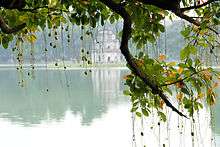Barringtonia acutangula
| Barringtonia acutangula | |
|---|---|
 | |
| A Barringtonia acutangula tree on the Hoan Kiem Lake | |
| Scientific classification | |
| Kingdom: | Plantae |
| (unranked): | Angiosperms |
| (unranked): | Eudicots |
| (unranked): | Asterids |
| Order: | Ericales |
| Family: | Lecythidaceae |
| Genus: | Barringtonia |
| Species: | B. acutangula |
| Binomial name | |
| Barringtonia acutangula (L.) Gaertn. | |
| Synonyms[1] | |
| |
Barringtonia acutangula is a species of Barringtonia native to coastal wetlands in southern Asia and northern Australasia, from Afghanistan east to the Philippines and Queensland. Common names include freshwater mangrove, itchytree and mango-pine.[2]
Description
This plant is a big tree that grows to about 8–15 m high. Its leaves are thick, smooth and oval in shape, about 8–12 cm long and 4–5 cm wide, with reddish petioles about 0.5–1.0 cm long. The plant has drooping raceme of up to 50 cm long, with numerous large, white flowers. Its fruit is oval-shaped and about 3 cm long, with 1 seed inside.[3]
Uses
Food
The young leaves of this plant are consumed as food, such as in Vietnam where they are eaten fresh with other vegetables, meat and shrimp.[3]
Medicinal
Research on this plant has reported a number of medicinal uses, including antitumor (seed extract),[4] antibiotic,[5] inhibition of growth of Helicobacter pylori,[6] antinociceptive activity[7] and antifungal activity.[8][9]
Chemistry
Its bark contains potent opioid painkillers
Also 3,3'-dimethoxy ellagic acid, dihydromyticetin, gallic acid, bartogenic acid and stigmasterol,[10] triterpenoids, olean-18-en-3beta-O-E-coumaroyl ester and olean-18-en-3beta-O-Z-coumaroyl ester[11] 12, 20(29)-lupadien-3-o[12]
Oleanane-type isomeric triterpenoids:- racemosol A (1) [22alpha-acetoxy-3beta,15alpha,16alpha,21beta-tetrahydroxy-28-(2-methylbutyryl)olean-12-ene] and isoracemosol A (2) [21beta-acetoxy-3beta,15alpha,16alpha,28-tetrahydroxy-22alpha-(2-methylbutyryl)olean-12-ene].[13]
Saponins,:[14][15] barringtoside A, 3-O-beta-D-xylopyranosyl(1-->3)-[beta-D-galactopyranosyl(1-->2)]-beta-D- glucuronopyranosyl barringtogenol C; barringtoside B, 3-O-beta-D-xylopyranosyl(1-->3)-]beta-D-galactopyranosyl(1-->2)]-beta-D- glucuronopyranosyl-21-O-tigloyl-28-O-isobutyryl barringtogenol C; barringtoside C, 3-O-alpha-L-arabinopyranosyl(1-->3)-[beta-D-galactopyranosyl(1-->2 )]-beta-D - glucuronopyranosyl barringtogenol C.
Photos
-
_in_Kolkata_W_IMG_8539.jpg)
in Kolkata, West Bengal, India.
-
_fruits_in_Kolkata_W_IMG_8547.jpg)
fruits in Kolkata, West Bengal, India.
-
_fruits_in_Kolkata_W_IMG_8545.jpg)
fruits in Kolkata, West Bengal, India.
-
_flower_buds_in_Kolkata_W_IMG_8546.jpg)
flower buds in Kolkata, West Bengal, India.
-
_in_Hyderabad_W_IMG_8323.jpg)
Tree in Hyderabad, India.
-
_in_Hyderabad_W_IMG_8321.jpg)
Flowers in Hyderabad, India.
-
_in_Hyderabad_W_IMG_8320.jpg)
Flowers in Hyderabad, India.
-
_in_Hyderabad_W_IMG_8318.jpg)
Flower buds in Hyderabad, India.
-
_in_Hyderabad_W_IMG_8316.jpg)
Flowers in Hyderabad, India.
-

Flowers in Dombivli, India
References
| Wikimedia Commons has media related to Barringtonia acutangula. |
- ↑ "Barringtonia acutangula". World Checklist of Selected Plant Families (WCSP). Royal Botanic Gardens, Kew. Retrieved 7 Mar 2016.
- ↑ Germplasm Resources Information Network: Barringtonia acutangula
- 1 2 Tanaka, Yoshitaka; Van Ke, Nguyen (2007). Edible Wild Plants of Vietnam: The Bountiful Garden. Thailand: Orchid Press. p. 88. ISBN 9745240893.
- ↑ Samanta SK.; Bhattacharya K. Mandal; C. Pal BC. (2010). "Identification and quantification of the active component quercetin 3-O-rutinoside from Barringtonia racemosa, targets mitochondrial apoptotic pathway in acute lymphoblastic leukemia". Journal of Asian Natural Products Research. 12 (8): 639–48.
- ↑ Rahman MM.; Polfreman D.; MacGeachan J.; Gray AI. (2005). "Antimicrobial activities of Barringtonia acutangula". Phytotherapy Research. 19 (6): 543–5.
- ↑ Bhamarapravati S.; Pendland SL.; Mahady GB. (2003). "Extracts of spice and food plants from Thai traditional medicine inhibit the growth of the human carcinogen Helicobacter pylori". In Vivo. 17 (6): 541–4.
- ↑ Deraniyagala SA.; Ratnasooriya WD.; Goonasekara CL. (2003). "Antinociceptive effect and toxicological study of the aqueous bark extract of Barringtonia racemosa on rats". Journal of Ethnopharmacology. 86 (1): 21–6.
- ↑ Vijaya Bharathi R.; Jerad Suresh A.; Thirumal M.; Sriram L.; Geetha Lakshmi S.; Kumudhaveni B. (2010). "Antibacterial and antifungal screening on various leaf extracts of Barringtonia acutangula". International Journal of Research in Pharmaceutical Sciences. 1 (4): 407–410.
- ↑ Sahoo S.; Panda P.K.; Behera P.S.; Mishra S.R.; Ellaiah P. (2008). "Antifungal activity of Barringtonia acutangula against selected human pathogenic fungi". Indian Drugs. 45 (1): 26–30.
- ↑ Chemical constituents of mangrove plant Barringtonia racemosa]. [Chinese] Sun HY. Long LJ. Wu J. Zhong Yao Cai. 29(7):671-2, 2006 Jul.
- ↑ Two new 18-en-oleane derivatives from marine mangrove plant, Barringtonia racemosa. Yang Y. Deng Z. Proksch P. Lin W. Pharmazie. 61(4):365-6, 2006 Apr.
- ↑ Antimicrobial activities of Barringtonia acutangula. Rahman MM. Polfreman D. MacGeachan J. Gray AI. Phytotherapy Research. 19(6):543-5, 2005 Jun
- ↑ Oleanane-type isomeric triterpenoids from Barringtonia racemosa. Gowri PM. Radhakrishnan SV. Basha SJ. Sarma AV. Rao JM. Journal of Natural Products. 72(4):791-5, 2009 Apr.
- ↑ Saponins from Barringtonia acutangula. Pal BC. Chaudhuri T. Yoshikawa K. Arihara S. Phytochemistry. 35(5):1315-8, 1994 Mar 30
- ↑ Acutangulosides A-F, monodesmosidic saponins from the bark of Barringtonia acutangula Mills C., Carroll A.R., Quinn R.J. Journal of Natural Products 2005 68:3 (311-318)